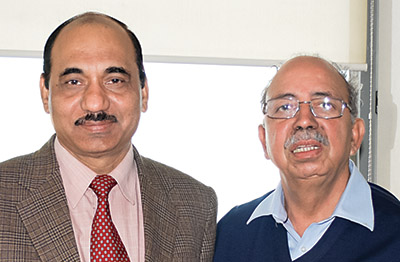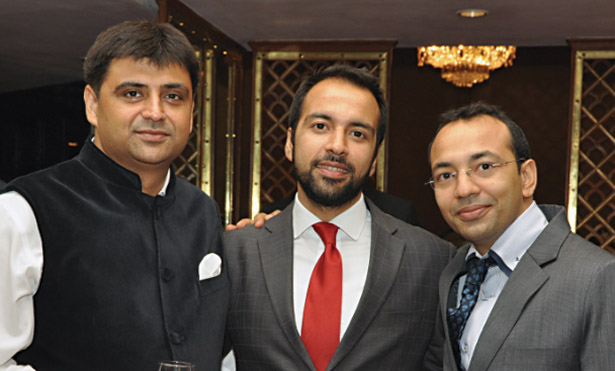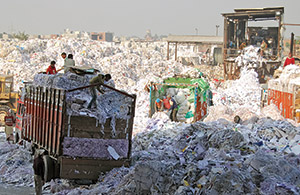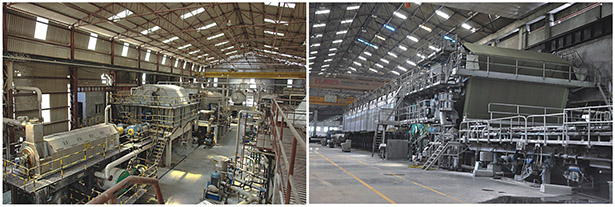Starting in a small way in 1965 with the dream of one man, Khanna Paper Mills Ltd (KPM) has grown into a reputed company with the hard work and vision of many. In its earliest days, it manufactured 200 kg of paper per day; it currently manufactures 330 tons of writing and printing paper, 370 tons of newsprint and 350 tons of board every day. It produces 1000 TPD board, writing and printing paper and newsprint grade with 100 per cent recycled fibre. KPM is the first paper mill in India to produce good quality writing and printing paper from 100 per cent deinked pulp. Its distribution network of 100+ dealers has a reach not only over the length and breadth of India, but also in few other countries of the world.
The 100-acre mill campus houses two plants that produce high-quality board, a plant that produces quality newsprint, a plant that produces writing and printing paper and two deinking plants that produce pulp by recycling waste paper. Its presence in the US strategically enables it to procure high-quality recycle fibre from around the world. The company procures a substantial amount of waste paper every year through its collaborative network of partners around the world for sourcing waste paper. Its enduring relationships and contracts ensure cost and operational efficiency, which leads to long-term sustainability.
The Paper Mart team recently had a face-to-face conversation with Dr. Ashok Kumar, President, Khanna Paper Mills Limited. During this warm interaction, the Paper Mart team gathered a lot of information about the phenomenal rise of KPM, its core strengths and its future plans. Given below are excerpts from this information-packed interaction.
Taking Right Decision
Speaking about the incredible growth of KPM in recent years, Dr Kumar said, “Although I have been a part of this company only for the last few months, I can say with surety that KPM has grown from a small unit to a big company – thanks to the management’s clarity of vision and implementation of sound and effective strategies. I think the company owes a lot to the efforts made by our chairman Mr. B.M. Khanna. But let me tell you that the company was bound to rise and shine because those who founded it knew from the very beginning what they wanted to do, where they wanted to be in times to come. So they always took the right decisions and they got their assets at the right time. The next generation that makes up the Board of Directors include Mr. Saurabh Khanna, Mr. Rahul Khanna and Mr. Suneet Kochhar. They have not only continued with the vision and philosphy of Mr B.M. Khanna but have taken it forward by installing the right plant and machinery ensuring growth, synergizing various functions, improving product portfolio and focusing on volumes, efficiencies, cleaner production, quality, customer and people focus. I attribute the company’s success in recent years mainly to the management’s ability to take quick decisions ensuring growth and sustainability. I mean, the management has never failed to get the right equipment at the right time and the projects have been installed and commissioned as quickly as possible. If you don’t take a long time to buy the equipment you need, you not only get the equipment at a lower price, but you also start working quickly. Another striking feature of the company is that it has been working on a very low inventory – three- to four-day product inventory, which is remarkable. You can have a low inventory only if you take decisions quickly and have a good relationship with your customers. KPM excels in both quick decision-making and maintaining a good relationship with its customers. All this has helped the company in getting its money back faster. In other words, all this has made our corporate cycles better.”
“We currently make about 1,020 metric tons of paper and board every day, which includes board, writing and printing and newsprint – about one-third each… . So, the synergy among the products is very good, and it helps to maximise the yield of waste paper. Since we have a respectable scale of operation, our fixed cost is quite manageable.”
Waste Paper Sourcing
Listing the factors behind KPM’s success, Dr Kumar said, “The other good thing we have done is that we have gone for our own waste paper sourcing. We currently consume around 35,000 metric tons of waste paper every month. Earlier, imported waste paper used to come through various traders. We now have our own procurement arm in the US in form of Khanna Paper Inc. Its job is to purchase recycled fibre mainly from the US. We can now source a large quantity of waste paper – more than what we actually need. So we have now started trading waste paper as well. All this has enabled us to have a grip on pricing and quality. Being among traders is beneficial because you know that you will get the right kind of stuff at the right time. You don’t have to worry about quantity and quality.”
Speaking about domestic waste paper sourcing, Dr. Kumar said, “As far as domestic sourcing is concerned, most of the waste paper we need comes from our own collection hubs. We have five hubs in Punjab, four in Delhi and one at Gurgaon. We get waste paper directly from these hubs; we don’t have to engage traders. There is no other paper company in India that has this kind of mode of procurement at this scale. So we owe a great part of our corporate success to our waste paper sourcing.”
Paper Industry: Challenges
Highlighting the challenges that the paper industry in India currently faces, Dr. Kumar said, “There are quite a few challenges that the Indian paper industry has been facing over a period and the same have become more critical now. Availability of fibrous raw materials has always posed an enormous challenge for the industry. The price of wood has skyrocketed in the last few years – and that’s because wood is not easily available. Besides, there is an acute shortage of land where you can grow trees. There is no government support that can provide you with land. So, how can we get wood today? By and large, the paper industry gets it through agro farm forestry. If you go to a country like Indonesia, you will see big paper companies and a huge forest area. In such countries, you have the assurance of supply of quality raw material both at an affordable price and within a short radius of the paper industry – something that we don’t have in India. So, paper mills in India need to focus really hard on their catchment areas to find ways of growing wood because inland transportation costs are very high in our country. Paper companies are encouraging interaction with farmers and the social forestry movement is becoming stronger, which is a good trend.
“The total production of paper of various grades in India is 12 million metric tons. About 45 per cent of this quantity of paper comes from waste paper-based mills. Good quality fibrous waste paper comes from abroad – regions such as the US, the Middle East and Europe. But let me tell you that only those companies that will have an assured supply of the majority of their waste paper requirement through their own domestic sourcing will emerge as real winners, because they will have greater control of quality, supply and, to a large extent, price. This will need a lot of emphasis not only on collection but also on generation, that is, improving the recycling of waste paper.
“Getting technically qualified manpower is yet another challenge that the industry currently faces. It is not easy to attract talent, and it is more difficult to retain it. So we need to go for some kind of tie-up with institutions and improve our training and developmental facilities. It has been observed that whenever any new plant comes up, the manpower from other mills is taken at higher compensation which in short term create problems with the old employees and in long run with the new recruits whom the company finds difficult to justify. We must, therefore, create our own talent pool and take good care of our employees through regular interaction and genuine concern about their growth. It is very important to inform them about their career path in the company and invest more in training and developing them.”
The Positive Side
Turning to the positive side of the paper industry in India, Dr. Kumar said, “In the last one decade, the Indian paper industry has done well in the area of technology upgradation. Many mills are now using state-of-the-art machinery, which are efficient in every way and can manufacture world-class product. The new equipment has not only made paper mills more efficient and competitive, but also enabled them to manufacture top-quality paper. Many paper mills have also spent quite a bit of their money on improving their environmental management, which gets more and direct focus from the top management. Paper mills are focusing more and more on how to reduce their energy and water consumption, reduce wastages and improve product quality. Availability of water presents a challenge because our rivers cannot provide us with the quantity of water we need for paper production. Many paper mills have installed state-of-the-art effluent treatment plants, which more than meet the norms prescribed by the regulatory authorities. More importantly, environment remains on the radar of the top management of the company, which is a major change in recent times. The technology that can make a mill’s operations sustainable in all respects is nowadays available but it is definitely expensive. Even then most of the mills have gone for state-of-the-art technology in the area of pulping, recovery and papermaking and have also scaled up their production to a more respectable level now.
Interestingly, paper industry, by its very nature, is sustainable… . This may come as a surprise to those who do not have an insight into the paper industry. For instance, the industry’s raw material comes mainly from plantation, which is renewable. Also, the products that it manufactures are recyclable. I think paper industry is the one that is truly sustainable. Unfortunately, its reputation suffers from the negative publicity by those sections that do not know the developments that have taken place in the last 10-15 years. With my background of academic research and 20 years of experience in the industry, I can only say that the paper mills of today in India are very different from what they used to be about 10 years ago. One has to visit the mills to see for themselves the improvements made by these mills over a period of time despite several constraints. We need to communicate to people outside the industry that the industry is absolutely sustainable and does not harm the environment in any way if the operations are run and managed in a responsible manner.”
Energy and Water
Focusing on the difficult task of generating steam and power for Indian paper mills and KPM’s approach to the issue of getting energy and water, Dr. Kumar said, “When it comes to generating steam and power, paper mills have replaced their old equipment with state-of-the-art energy efficient equipment. Boiler efficiency is highly important; your emission should be as little as possible. So, all the old equipment – cooling tower, boiler and turbines – should make way for new energy-efficient equipment. There has been lot of awakening in this area and number of forward looking mills invested a huge amount in this field. KPM has also been focusing on this area. It has been acquiring equipment that is energy-efficient and environmentally compatible.
“As far as use of water is concerned, you have to close as many of your cycles as possible and go flat out for recycling. Get equipment that enables you to separate your fibre from fillers wherever. Clean up your water and use as much of it as possible. After all, drinking water for drinking purposes is more important and will have priority for society than water needed for producing paper. Shrinking groundwater is a major issue in Punjab and many other states. KPM is planning to get the right kind of technology – a technology that can enable it to use water and energy efficiently irrespective of its higher cost. The company has set aside quit a bit of its resources for improving its environmental management. We are currently doing some trials with innovative approach, which will bear good results. If this technique is successful, we will be able to reduce a significant amount of our water consumption.”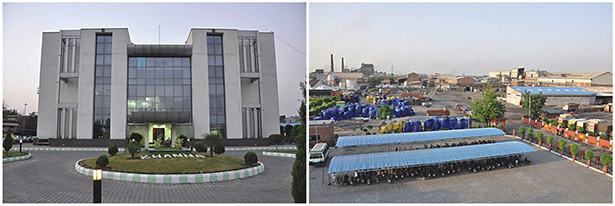
Future Targets
Speaking about KPM’s future plans, Dr. Kumar said, “Like I mentioned before, we are in commodity business and so we have to keep growing. The company is seriously exploring the possibilities of further growth and diversification. Packaging is an area that will grow faster than any other paper-related area. So, we are looking into the possibilities in this segment. As we are not a location-specific company, we don’t mind moving to any good location in the country as far as further growth and diversification are concerned. Needless to say, technology will take centre stage.
“You see, paper mills have to grow and expand because the country is growing rapidly. Unlike developed countries in North America and Europe, the demand even for writing and printing papers is still positive due to rising literacy rate. Besides, government policies are also prompting us to grow and expand. Of course, we would like to grow in areas related to paper, but we have not ruled out the possibilities of diversifying in other areas.”
Indian Paper Industry
Speaking about the prospects of the Indian paper industry, Dr. Kumar said, “The good thing about the paper industry is that it is a growing industry. In the next seven years, production will rise from 12 million metric tons to 22 million metric tons. The market for paper in India is bound to grow. So there are opportunities for everyone. What matters most is how we manage our capital, because the interest rate in India is high. Mills have to be located closer to the source of our raw material. We need to ensure that the equipment we use is environment friendly. Also, cost will be a big differentiator.
“Now that most of the paper mills in India are manufacturing quality products, more emphasis should be given to exports – especially to countries where we can have better margins. We may not be able to compete with big players in China and Indonesia in certain market segments because our cost of production is higher than that of Chinese and Indonesian manufacturers. All the same, we need to make special efforts in this direction. We can always offload some of the excess quantity as and when necessary to get a better price for our product. However, we need to improve our quality further and build up long-term relations with the customers.
“As we are in commodity business, cost matters a lot to us. As a manufacturer, you need to have different strategies to address your cost issues. Margins will always remain under pressure as the cost is bound to increase due to increase in input prices. The industry cannot pass on the load of cost increase entirely to the customer. So, you have to make your operations as efficient as possible. Needless to say, quality in our business is of paramount importance. In the last ten years or so, many mills have been able to ensure quality by meeting international standards. But there are still many mills that need to improve the quality of their products; they can do that by going for the latest technology and adopting operational excellence.
“We also need to invest more in research and development. Not many in India like to invest in R&D. Mills in the US and Europe regularly invest in R&D. Likewise we should also encourage in-house R&D and get support in this area from outside the country. We also have to be very customer-focused and must try hard to build up good customer relationships. KPM makes special efforts at building up good relationships with its customers. In our newsprint segment, we are very close to our customers. We make around 11,000 metric tons of newsprint every month, but we do not face much problem with selling it – and that’s because of the quality and service delivered to our customers and building long-term relationship with them over a period of time. Also, good marketing intelligence helps a lot in better decision making. KPM makes special efforts to meet its commitments. So far, we have not failed to meet our financial and delivery-related commitments – and all that has enhanced our reputation. It is important in the business to make best efforts to meet the commitments in order to build a long-lasting reputation with humility.”


